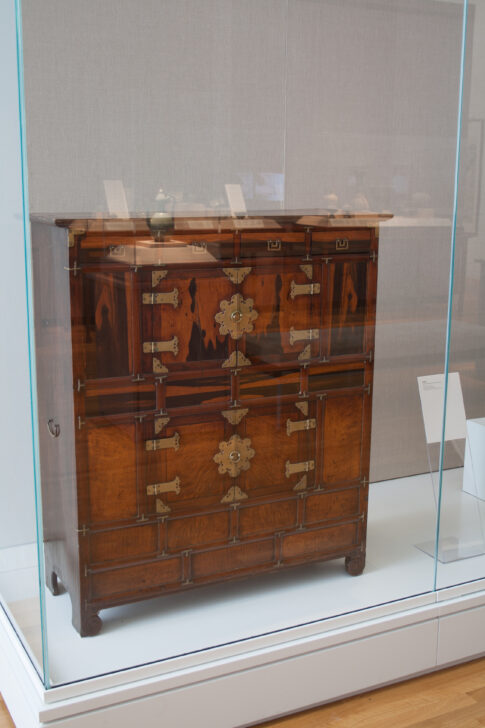Chest
Korean

Description
Chest
Korea
Joseon period (1392–1910)
ca. 1800
Wood
Gift of Ellen Johnston Laing. 2017/2.125
This type of chest, or bandaji, was widely used for storage in men’s
and women’s quarters during the Joseon period. Bandaji have single
or multiple front doors and spacious interior chambers for clothes
and books. This one is also equipped with four small drawers on top
for documents. Joseon furniture was usually simply coated with oil to
highlight the natural wood grain, which became the main decorative
element, accentuated by brass fittings in geometric shapes or with
auspicious motifs. The austere aesthetic of the Joseon period was
consistent with the ruling ideology of Neo-Confucianism, which
rejected ostentatious displays of wealth. Despite the plain appearance
of the chest, highly skilled craftsmanship is evident in the application
of different types of front wood panels and in the deft construction,
which uses no nails.
Summer 2024 Gallery Rotation
____________________
Chest
Korea, Joseon period (1392–1910)
ca. 1800
Wood and brass fittings
On loan from Ellen Laing, LTL2010.6.1
Subject Matter:
This type of chest, or bandaji, was widely used for storage in men’s and women’s
quarters during the Joseon period. Bandaji have single or multiple front doors
and spacious interior chambers for clothes and books. This one is also equipped
with four small drawers on top for documents. Accentuated by brass fittings in
geometric shapes. Highly skilled craftsmanship is evident in the application of
different types of front wood panels and in the construction, which uses no nails.
Physical Description:
A tall chest with four main cabinet doors, two on top and two on bottom, and four smaller drawers on the top. Each door is fitted with brass hinges and accent pieces. The wood is multi colored, light brown and dark brown.
Produced to store clothes, chests were generally kept in the lady’s quarter (anbang ) of a house and used by women. The front panels are made from persimmon wood, while the top, sides and back are made from pine wood. The top panel is made from a single piece of wood with moldings attached to give a sleek design. The side panels extend to the back, and the back panel was joined to the side panels at a perpendicular angle. The top and side panels are joined by three tenons and mortises. The rail of the first and second levels are attached to the side panels by mortise-and-tenon joints. The borders of the doors on the first level are inlaid with blacklines. Rim decoration ogeumte has been added to the part under the lower crossbar which is supported by a pedestal with openings and scroll feet. There is a wooden door stopper inside the chest. The handles are attached to the side panels. This is a beautiful chest of which the rails, stiles, and posts are joined in Korean traditional style.
[Korean Collection, University of Michigan Museum of Art (2017) p. 269]
Usage Rights:
If you are interested in using an image for a publication, please visit https://umma.umich.edu/request-image/ for more information and to fill out the online Image Rights and Reproductions Request Form.